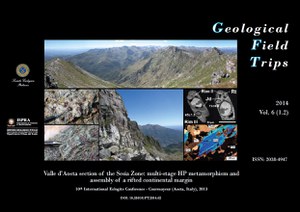Valle d'Aosta section of the Sesia Zone: multi-stage HP metamorphism and assembly of a rifted continental margin
10th International Eclogite Conference - Courmayeur (Aosta, Italy), 2013
The main focus of this field trip through central parts of the Sesia Zone is laid on the geology of the Eclogitic Micaschist Complex (EMC), notably on its petrographic, structural, and geochronological characteristics. The EMC is an impressive mass of polymetamorphic continental crust with a pervasive high-pressure (HP) imprint acquired during the Alpine orogeny. The outcrops visited offer insights into the processes at a convergent plate margin, involving continental subduction and collision, metamorphism and deformation under eclogite facies conditions, followed by rapid exhumation and partial retrogression. Additional topics of this field trip address the magmatism associated with pre-collisional rifting of the Adriatic continental margin and the relation of the Sesia Zone to the adjacent Piemonte oceanic units.
The outcrops selected are set in a spectacular scenery and provide ample opportunities to examine HP rocks. The spectrum characteristic of the EMC ranges from eclogites (containing omphacite and/or jadeite, garnet, phengite, glaucophane, zoisite, chloritoid, rutile) to phengite schists, calcschists, and marbles, as well as a variety of orthogneisses. Despite the intense polyphase deformation and HP-metamorphic recrystallization, it is possible in some locations to recognize pre-Alpine characteristics in some of the protoliths. For instance, two types of felsic orthogneiss can be distinguished in the Aosta Valley, one derived from Permian granitoids (with local preservation of intrusive contacts, magmatic inclusions, leucocratic veins and other magmatic structures; Stop 3), the other derived from pre-Variscan leuco-monzogranite, such as the building stone mined at the “Argentera” quarry near Settimo Vittone / Montestrutto (Stop 2; so-called “Verde Argento” contains jadeite, phengite, K-feldspar, quartz).
Polycyclic and more rarely monocyclic metasediments contain evidence of a complex Alpine PTDt-evolution, locally including relics of their prograde history from blueschist, one or more stages at eclogite facies. Recent petrochronological studies have dated this HP-evolution of the Sesia Zone in some detail. In the area visited, clear evidence of HP-cycling has been identified in one km-size tectonic slice (Stop 1), but not in adjacent parts of the EMC, indicating “yo-yo tectonics”. Partial retrogression and attendant ductile to brittle deformation of the HP-rocks is evident in one of the outcrops (Stop 4).
Apart from the four localities in the Sesia Zone, a final outcrop introduces HP-rocks of the adjacent Piemonte oceanic unit, specifically calc-schists and ophiolite members of the “Zermatt-Saas” zone. The hilltop outcrop (Stop 5) displays foliated antigorite schist with peridotite relics (clinopyroxene, spinel) containing lenses derived from doleritic dykes. These fine-grained metarodingites and the folded veins containing Mg-chlorite and titanoclinohumite within serpentinite once again indicate equilibration under low-temperature eclogite facies conditions. However, these units reached that HP stage more than 20 Ma after the youngest eclogite facies imprint recognized in the Sesia Zone.
Despite nearly half a century of intense study in the Sesia Zone, the complex assembly of its HP-terranes and their relation to more external parts of the Western Alps remains incompletely understood. This field guide merely introduces a few of the classic outcrops and discusses some of the critical evidence they contain, but it could not incorporate details on each stage of the evolution recognized so far.
DOI 10.3301/GFT.2014.02

